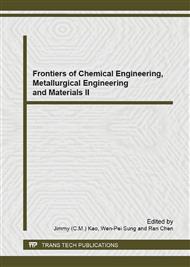p.137
p.142
p.145
p.149
p.153
p.157
p.161
p.165
p.169
Polyaniline-Attapulgite Composites Based on Ionic Liquid: Preparation and Characterization
Abstract:
Using 1-methyl-3-alkylcarboxylic acid imidazolium chloride ([CMMICl) ionic liquid (IL) as synthetic environment, CMMIm-PANI and CMMIm-PANI@ATP composites were successfully prepared via in situ chemical oxidation polymerization. The chemical characterization of the material before and after ATP adding was performed by means of Fourier transform infrared spectroscopy (FTIR). The morphology of the coatings was observed employing scanning electron microscopy (SEM). The results are further indicated that PANI which coated on the surface of rodlike crystal ATP helped the formation of conductive path among ATP crystals which overlapped each other. The four probe conductivity apparatus was used to analyze the electronic properties of the composites. The conductivity of CMMIm-PANI@ATP and CMMIm-PANI are 10 S/cm and 1.8 S/cm respectively, which clearly showed that the introduction of ATP in composite makes the conductivity increased largely. In addition, thermogravimetric analysis shows that the thermal stability of CMMIm-PANI/ATP composites was enhanced and these can be attributed to the effect of coated ATP as barriers for the degradation of PANI.
Info:
Periodical:
Pages:
153-156
Citation:
Online since:
September 2013
Authors:
Price:
Сopyright:
© 2013 Trans Tech Publications Ltd. All Rights Reserved
Share:
Citation:


